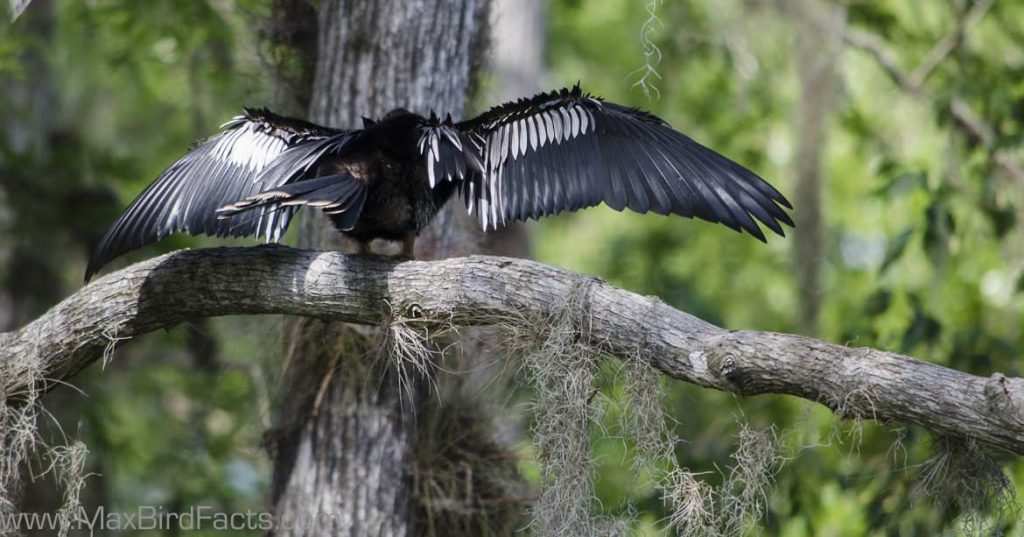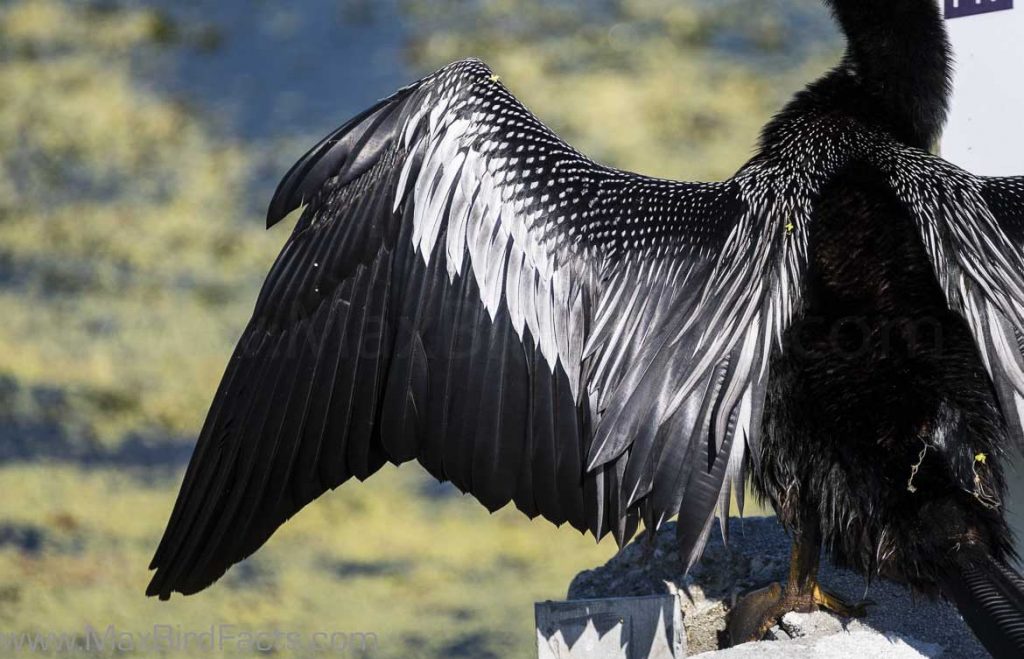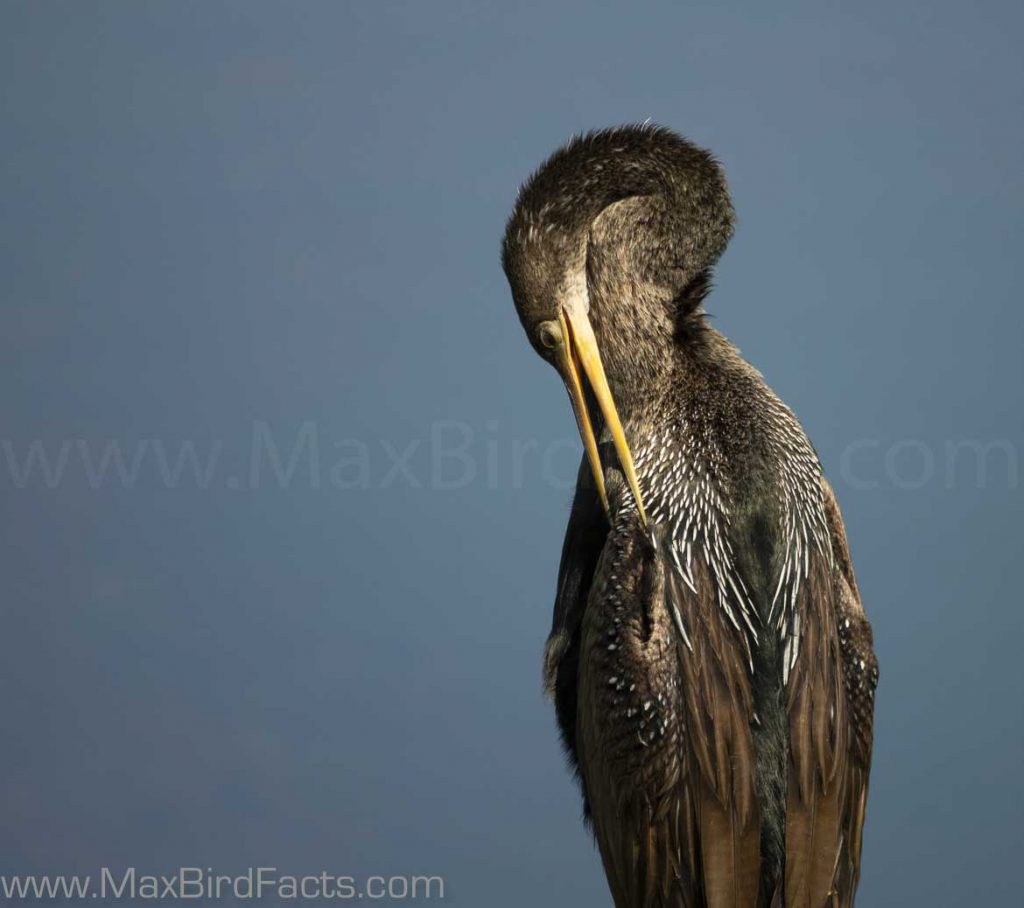Heat exchange is a notable element of life. Every living thing is continually either losing or absorbing energy from the world around it.
Here in Florida, Anhingas are a moderately common bird. Suppose you are fishing along a lakeshore, kayaking down a river, or birding in wetlands. In that case, you will most definitely see one of these birds.
So, how do Anhingas thermoregulate? These birds thermoregulate by perching on an open area, spreading their wings, and turning their back to the sun.

By doing this, they are functionally turning the dark-colored feathers on their back and wings into solar panels, absorbing as much radiation as possible. There are a couple of reasons why these birds need to perform this behavior.
Their feather’s function is very different than that of a duck. Instead of repelling water, an Anhinga’s feathers absorb it.
Also, swimming in water for even short periods can lower the bird’s body temperature. Spring-fed rivers here in Central Florida are at a constant 72˚F all year. Comparing this to the average body temperature of a bird, 106˚F, this is extremely low.
Before getting into this article, I thought it would be tiresome only to call these birds Anhingas. So I will also call them some of the local common names to spice it up: Darter, Snakebird, and Water-turkey.
With that said, let’s talk about why their feathers absorb water instead of repelling it.
Barbs, Wicking, and Buckskin Leggings
The majority of shorebirds, waterfowl, and seabirds all have extremely waterproof feathers to keep them dry.
Ducks can spend all day bobbing in a pond, diving down to catch crustaceans and aquatic vegetation. However, when they waddle onto the shore, their feathers are damp at most.
Uropygial oil, secreted by a gland near the base of a bird’s tail, provides the necessary waterproofing agent. When a bird preens, it will pick up some of this oil and use its beak to spread it across the feathers.
We all know oil repels water. The fascinating thing with Anhingas is they seem to have given up this luxury.
Snakebirds haven’t lost the uropygial gland, and it is still present at the base of their tail and used while preening. However, this is not to say it keeps the feathers dry.

Again, with our comparison between ducks and Anhingas, when a duck dives and swims underwater, it can shake the beaded droplets off its back. When an Anhinga comes out of the water from a hunt, it is dripping wet, with the feathers on the wings and body visibly saturated.
Their feathers do dry off quickly, and this comes from two adaptations. The first is the feather’s structure itself.
Each feather is made of many branching structures, called barbs, which increase its surface area. This improvement in surface area allows wind and heat from the sun to dry them off faster.
We as humans have used this method of quick-drying in the past as well as the present. Mountain men and Native Americans would dress in buckskin jackets and leggings and attached tassels or fringes to them made from strips of leather.
When the clothes became wet, these fringes would draw the water away from the primary part of the clothing, causing them to dry significantly faster. You might also know this as a wicking layer of clothing today. It draws the moisture away from the body for easier evaporation.

The second adaptation that allows the Anhinga to dry off quickly is its dark coloration. Dark feathers absorb more heat and light than light-colored ones.
We will cover the details more in-depth in its own section, but these birds have black feathers that absorb sunlight more readily.
By heating the feathers quickly, the birds can dry the barbs faster and become more efficient when flying and keeping warm.
Water is excellent at removing heat from the body, and this is why we sweat. But an animal might not always need this loss in heat.
With a difference of over 30˚F between the water temperature and the bird’s body temperature, they will need to heat up rapidly. If the Darters don’t, they could risk becoming ill or grow slow and stiff.
Growing up here in Florida, I can tell you 72˚F spring water is not the same as setting your thermostat to the same temp. Because water is molecularly denser than air, it sucks away heat much faster.

Once you get out of that chilly spring, the air is pulling even more heat away from you while the water evaporates. Insulative feathers do help with this. However, when these feathers become wet, they lose some of this efficiency.
If you want to read about the epitome of waterproofing and insulative feathers, check out my article: Do Penguins Have Feathers – The Role of Insulation & Waterproofing.
So for an animal that spends so much time in cool water, why would it risk becoming wet? These adaptations are great for drying off the birds quickly, but why not be like a duck and become completely waterproof?
Let’s dive right into that.
Feathery Dive Belt
There is a reason Anhingas have taken the route of absorbing water rather than repelling it.
Looking back at our ducks, when they dive for prey, the oily feathers are continuously trying to push the bird back to the surface. The same thing that keeps the bird dry on land also tries to keep them dry by forcing them to stay out of the water.
Anhingas are underwater hunters. They use their snake-like neck and spear-shaped beak to strike at fish as they swim using their webbed feet.
Because of this amphibious lifestyle, it would be more beneficial for the bird to be somewhat hindered on land because of an advantage they get underwater.
Once the feathers become wet, they cause the Snakebird to become neutrally buoyant (neither floating nor sinking). With the reduced amount of oil used when preening, they don’t have to fight its relentless pull to the surface.

With the adaptations we’ve touched on (the structure and color of the feathers), they can dry off quite fast.
These adaptations are necessary for Anhingas to thermoregulate efficiently. And if you’ve read any of my other articles, you know efficiency is the fundamental goal of any bird.
Some recent research is suggesting Anhinga feathers are well waterproofed. One of the main arguments supporting this is that Anhingas still use their uropygial gland when preening.
I personally disagree with this theory. Even though these birds use this gland while preening, that doesn’t mean they are using it to the same extent as other birds.
Looking through my photos of Anhingas and comparing them to waterfowl, there is a clear difference between the two when coming up from being submerged.

Ducks that pop up from underwater immediately have it bead off their feathers. As the water tension breaks, there is no resistance while it falls off them and back into the pond.
When an Anhinga surfaces, the water tension breaks but the feathers are noticeably wet. Both the primary flight feathers and the covering body feathers will drip with water after swimming.
Another argument from the group supporting waterproofed Water-turkeys is that they can still fly while being wet. Continuing by stating they don’t appear to be hindered by the water while taking off.

Again, I think this statement is faulty. I have gotten closer to basking Anhingas than nearly any other bird. They will grunt, hiss, extend their gular (throat pouch), and spread and flap their wings all to try and frighten you away.
I believe this increased defensive performance and reluctance to retreat is because they don’t want to take flight while weighed down with water.
Even when I stay low and as quiet as possible, I cannot get even half as close to herons, songbirds, raptors, ducks, or any other bird without it flying off and screaming at me.
Why would Anhingas be any different? Why wouldn’t it just take off when a human gets close instead of this loud and jarring display?

Every behavior has a reason, and this is no different. Again, I think Snakebirds go through this lengthy process of trying to scare away potential threats, so they don’t have to fly while wet.
Further, if their waterproofing was good enough that they were bone dry when they get out of the pond, what is the advantage to wasting energy doing this? Why would the bird want to draw attention to itself and make it more noticeable to predators by becoming displeasing and noisy?
I will need to test this next time I go out birding, but in the past, when I come upon a dry Anhinga, it will take off much faster than a wet one. By this, I mean that it will flee from me when I am farther away when compared to wet birds.
This is all my opinion and speculation based on what I’ve seen while photographing and watching these animals. I personally think they do become wet as an adaptation to be better underwater hunters.
Yes, they use their uropygial gland and oil while preening for some waterproofing, but it isn’t the same as in other birds. The feather’s structure of barbs and dark coloration allow these birds to dry off fast and efficiently.

The oil itself acts as a conditioner and parasite deterrent to the feathers. This could be the gland’s primary purpose in Darters, primarily serving to keep the feathers clean and looking handsome rather than waterproof.
Anhingas can still fly while wet but are reluctant to do so because of the extra energy they will exert. Instead of flying, they resort to being obnoxiously loud in an attempt to scare off threats and bird nerds before abandoning their perch.
Let me know what you think of this theory and if you have any input for either side.
But now, let’s get back into how anhingas thermoregulate, specifically now using their black feathers.
Tanning After a Dip
To understand why Anhingas are black and this color’s purpose, we need to learn a bit about plants and how we see color.
The color black is caused by the absorption of all other colors and light. We see color principally through the reflection of the wavelengths of light that are not absorbed by the object.
This absorption and reflection are how photosynthesis and chlorophyll work in plants. Chloroplasts, organelles within plant cells that contain chlorophyll, absorb the red wavelengths of light and reflect their counterpart, greens, and blues.
They absorb red because it is the highest wavelength and lowest frequency of visible light/color, making it the most available when on land and near the water’s surface. Red algae found deeper in the ocean is caused by the same need.
The blue wavelength of light can penetrate through the water to reach these plants and still provide them with the required amount of light for photosynthesis because of its greater frequency interval. Because these algae are absorbing blue wavelengths, they will reflect the red ones, which is why we perceive them as red.
So, how does this tangent with plants help us understand why Anhingas are darkly colored? For the same reason plants are a selective color, so they can reflect whatever else they don’t demand.

As I said earlier, black is caused by the absorption of all colors. Since color is formed by light and its reflection, dark colors will absorb all the light that hits them.
Additionally, light is equivalent to energy and heat. Meaning dark-colored objects will heat more quickly than lighter-colored ones.
If you want to read more about this, check out my article Why do Vultures Spread Their Wings – Feathered Solar Panels. One of the examples I used in that article on how this works is with a dark-colored car.
If you have a dark car and leave it out in the sun, it will become distinctly hotter than a lightly colored one. This is the exact mechanism the Anhingas are using.
Because their black feathers absorb virtually all wavelengths of light, Anhingas can quickly get their body temperature back up.
This rapid warming is paramount when these Water-turkeys spend much of their day swimming in chilly waters.
Dark-colored bodies are particularly prevalent in animals that need to absorb heat quickly. Looking at an American Alligator, these reptiles are nearly black to help them heat up posthaste after cooling off the previous night. A shorter period of warming will allow the animal to return to normal faculties faster.
Regaining heat after cooling off in the water will bring the bird back to normal function. This need for warmth could be another element of why Anhingas are so reluctant to take flight.

Think of when you are warm in bed, and your alarm goes off. You want to do everything you can to stay in bed and not have to get up.
When an Anhinga finds a nice perch and a warm patch of sunlight, this is equivalent to your cozy bed.
And when a crazy photographer or kayaker gets too close, the Snakebird will do whatever it can to stay in its warm patch before abandoning it.
And like I said in the previous section, when these birds are dry, they are much more ready to take off and fly.
Once they have dried off, the Darter will be closer to its average 106˚F body temperature. And if it is still a few degrees shy of that mark, muscle activity through flight will make up the difference.
Any activity while you are cold is much more taxing compared to being at your usual levels. These birds know this, and they want to stay as efficient as they can.
Trying to fly while cold or wet will result in more energy needed to move their muscles. The increased demand will require them to hunt more, putting them back into that cool water that creates the problem.
This is why Anhingas need to be darkly colored, absorbing as much sunlight and heat to warm up as quickly as possible.
How do Anhingas Thermoregulate
So, now we’ve learned some of the reasons these birds need to bask after swimming.
Their feathers absorb water to swim and hunt more efficiently, although this is a contended theory. The near 30˚F difference in temperature between the water and the bird’s body also forces it to warm up.
The feathers’ structure, formed by small barbs, allows the wind and warm sun to dry them quickly. Like our buckskin example, the barbs increase the feather’s surface area and draw the water out so it can be wicked away quickly.
The feather’s black color absorbs essentially all the wavelengths of sunlight, warming the Anhinga rapidly. This accelerated heat absorption is crucial so the Snakebird can return to maximum performance.

Taking on the horaltic pose, outstretching the wings, and fanning the tail, Water-turkeys use their dark backs to become solar panels. They need to find an open perch and sunlight to take full advantage of this, and they are very reluctant to give it up.
Being cold and weighed down with water, Anhingas will hiss and grunt at potential threats and try to appear as intimidating as possible. Darters perform this overblown performance so they can stay on their warm, comfy perch.
So, Anhingas thermoregulate through the horaltic pose and the dark color of their feathers to absorb as much sunlight as possible after swimming and hunting fish.
I hope you learned something new and can appreciate some of the strange but beautiful adaptations Anhingas have gone through!
Thank you so much for reading through my article. If you have any suggestions for future posts, please leave me a comment, and I will look into them!

Get Outside & Happy Birding!
Max
Discover more from Welcome to MaxBirdFacts.com!!!
Subscribe to get the latest posts sent to your email.

Pingback: Anhinga vs. Cormorant — Snakebird or Sea Raven? – Welcome to MaxBirdFacts.com!!!
Pingback: 5 Birds That Swim Underwater – Soaring Under The Waves – Welcome to MaxBirdFacts.com!!!
Really good work here Max I have recently become a watcher of Anhingas on Sy Simons Isl GA There is a female who comes to a perch by Dunbar creek every day around 5 pm I have seen her after landing poking her neck out straight and looking about alertly She seems to be searching for threats She will fly if boaters come by I wonder about their seeming penchant for soaring It would seem they do it for sheer satisfaction I can see no other benefit unless they did it while migrating cross country like sailplane pilots in a contest Anyway enough for now I will try to send more thoughts later Please feel free to email me
Thank you for the great comment, Douglas! I’ve seen Anhingas soar as well and they get to some pretty incredible heights. I think you might be right, heading to a new, quieter county could be the reason. They also might be able to see more area from higher up, and then spot a secluded lake or pond and land in it to be unmolested by boaters. Feel free to send me an email direct or leave more comments, hearing your insight was great! Also, St. Simons is a beautiful place and I was very lucky to have visited last year.
Wow, Max, you packed this article with so much great information. I knew a little bit about them, but you covered things I never even thought about. Your photographs are also gorgeous. Well done! I will not look at another Anhinga in the same way again, I have a much better appreciation for them now.
Thank you so much!!! That is my goal with these articles, and I’m glad you will look at these birds differently and with a new appreciation!